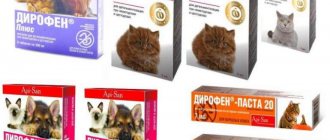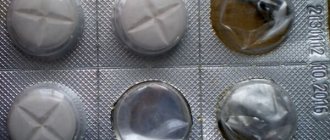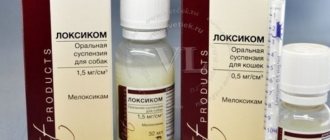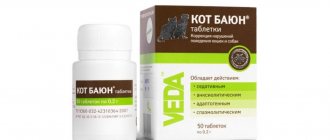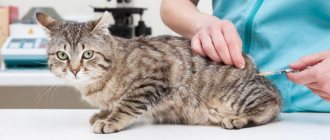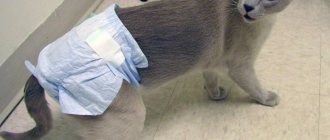Composition and properties of the drug
Stop Cystitis tablets for cats are made in the form of round pills weighing 120 mg, which are coated with a green coating. Each of them includes:
- nitroxoline – 12.5 mg;
- drotaverine hydrochloride – 10 mg;
- knotweed extract – 10 mg;
- horsetail extract – 10 mg;
- nettle leaf extract – 10 mg;
- licorice root extract – 10 mg;
- birch leaf extract – 10 mg;
- lingonberry leaf extract – 10 mg.
As excipients, Stop Cystitis tablets for cats contain carboxymethylcellulose, polyvinylpyrrolidone, sodium starch glycolate, calcium stearate and Opadry shell.
The drug is packaged in 15 or 20 tablets in polymer jars with plastic lids with first-opening control, which are placed in an individual cardboard box with instructions.
Stop Cystitis tablets for cats are stored away from feed and food, in a dry, dark place inaccessible to children at a temperature of -10°C to +25°C. If all conditions are met, the shelf life of the drug is 3 years from the date of release.
Analogues of stopcystitis
global $ads_google;
//data-ad-slot=”2475549904″ $ads_google = empty($ads_google) ? false : true; ?> if ($ads_google == false) {?> $ads_google = true; ?> } ?> The multicomponent composition is usually positively perceived by cats, and the drug itself is not an expensive shortage. But in some cases there is a need to find a worthy and suitable analogue. The following are suitable replacements for Stop Cystitis for cats:
- Divopride. The contents of the tablets consist of artichoke and milk thistle extracts.
- Kotervin. Urological drops, the formula of which is based on extracts of cinquefoil, horsetail, knotweed and kidneyweed.
- Healthy kidneys. The pills contain extracts of barberry, birch buds, horsetail, and dandelion.
- Urolex. Drops, the biological complex of which is composed of extractive substances of birch, bearberry, and goldenrod.
- Furagin. The medicine contains the compound nitrofuran, which has an antiseptic effect.
IMPORTANT!
It is recommended to choose an analogue for treatment after consulting with your veterinarian.
Indications for use and principle of action
Nitroxoline, which is part of Stop Cystitis tablets for cats, is a derivative of 8-hydroxyquinoline. It is active against many gram-negative and gram-positive bacteria, as well as some fungi that cause urinary tract infections (Salmonella spp., Escherichia coli, Corynebacterium spp., Ureaplasma urealyticum and Staphylococcus spp.). After oral administration, nitroxoline is quickly absorbed from the gastrointestinal tract and excreted unchanged by the kidneys.
Drotaverine hydrochloride has long-term vasodilating, myotropic and antispasmodic effects. It relieves spasms of smooth muscles of the urinary tract and bladder tenesmus. 45–60 minutes after oral administration, the maximum concentration of drotaverine hydrochloride is reached in the blood serum. It is metabolized in the liver and excreted from the body in the form of metabolites within 72 hours, 50% in feces and 30% in urine.
Biologically active components of medicinal plants (mineral compounds, vitamins, tannins, essential oils and flavonoids) promote the removal of stones in urolithiasis and have anti-inflammatory, antispasmodic, diuretic and antiseptic properties.
In terms of the degree of effect on the body, Stop Cystitis tablets for cats belong to class 4 and are considered low-hazard. In recommended doses they do not have a sensitizing or local irritating effect.
The drug is prescribed for the prevention and treatment of urolithiasis, acute and chronic inflammatory and infectious pathologies of the urinary tract (urethritis, pyelonephritis and cystitis), to prevent infections after diagnostic procedures and after operations to remove urinary stones.
Chronic cystitis: new in diagnosis and treatment
If the diagnosis of chronic bacterial cystitis in most cases does not cause difficulties, then treatment is not always effective, and the prognosis is not always favorable, since in some cases it is not possible to identify and then eliminate the cause of the disease. Treatment of chronic cystitis requires a doctor to have a broad outlook, knowledge of the problems of gynecology, neurology, and immunology. During the development of the disease, structural changes are ahead of clinical manifestations, and, conversely, during the recovery process, normalization of impaired functions occurs before the restoration of damaged structures, i.e., morphological manifestations are delayed compared to clinical ones [16]. Only mature epithelial cells are resistant to bacteria, while the barrier function of the epithelium in the presence of epithelial cells with a moderately differentiated ultrastructure is impaired. For the treatment and prevention of chronic recurrent lower urinary tract infections, etiotropic antibacterial therapy is used in 7–10-day courses. Research by Vozianova A.F., Romanenko A.M. et al. (1994) showed that complete restoration of mature surface epithelial cells of the bladder after their damage lasts at least 3 weeks [26]. Thus, in the absence of vigilance on the part of the attending physician and lack of due attention to the duration of pathogenetic treatment, another relapse may be layered on the reparative phase of the previous process. This in turn leads to increased collagen formation, discorrelation and sclerosis of subepithelial structures, which play a major role in the homeostasis of the bladder mucosa and its innervation [27]. Thus, a vicious circle arises: inadequate treatment - chronic inflammation - reactive changes and scarring of submucosal structures - tissue hypoxia - incomplete regeneration of the epithelium - another exacerbation of the process.
Treatment of chronic recurrent cystitis:
- Etiological: antibacterial therapy.
- Pathogenetic - correction of anatomical disorders, correction of immune disorders, improvement of microcirculation, treatment of STIs, correction of hormonal disorders, treatment of inflammatory and dysbiotic gynecological diseases, correction of hygienic and sexual factors, local treatment.
- Preventive - herbal diuretics, antibacterial therapy (including postcoital prophylaxis).
Etiological treatment is antibacterial therapy based on the following principles: duration (up to 7–10 days); choice of drug taking into account the isolated pathogen and antibiogram; prescribing antibiotics with bactericidal action. The drugs to which the largest percentage of sensitive strains of urinary infection pathogens have been isolated in Russia are: fosfomycin - 98.6%, mecillinam - 95.4%; nitrofurantoin - 94.8% and ciprofloxacin - 92.3% [28]. The most preferred are norfloxacin, ciprofloxacin, pefloxacin and levofloxacin due to the absence of unwanted adverse reactions.
The choice of antibacterial drug should be made on the basis of microbiological research data. If for acute uncomplicated cystitis, preference should be given to short courses of antibacterial therapy (3–5 days), then for chronic recurrent cystitis, the duration of antibacterial therapy should be at least 7–10 days for complete eradication of the pathogen, which in chronic cystitis can be localized in submucosal structures bladder walls [1, 5].
Antibacterial therapy. The drugs of choice are fluoroquinolones (ciprofloxacin, ofloxacin, norfloxacin, levofloxacin, lomefloxacin), which have very high activity against E. coli and other gram-negative pathogens of uroinfections. Non-fluorinated quinolones - nalidixic, pipemidic, oxolinic acids have lost their leading importance due to the high resistance of microflora to them, and cannot be the drugs of choice for recurrent urinary tract infections [18, 29].
The choice of fluoroquinolones is due to a wide spectrum of antibacterial activity, pharmacokinetics and pharmacodynamics, and the creation of high concentrations in the blood, urine and tissues. The bioavailability of fluoroquinolones does not depend on food intake; they have a long half-life, which allows taking the drugs 1–2 times a day. They are distinguished by good tolerability and the possibility of use in renal failure. For norfloxacin, the half-life is 3–4 hours; for the treatment of exacerbation of cystitis, it is recommended to take 400 mg 2 times a day for 7–10 days. Ciprofloxacin is considered the most powerful antibiotic from the group of fluoroquinolones, since, providing a bactericidal effect in small concentrations, it has a wide spectrum of antibacterial activity and is quickly distributed and accumulates in tissues and biological fluids with high intracellular concentrations in phagocytes (take 500 mg 2 times a day). Currently, drugs have been created that provide ease of administration - once a day. An example would be Ificipro® OD, which is a new sustained-release formulation of ciprofloxacin.
When an STI is detected, a course of antibacterial therapy is required with the inclusion of macrolides, tetracyclines, fluoroquinolones, aimed at eradicating the pathogen, followed by monitoring of the microflora.
Pathogenetic treatment begins with recommendations for maintaining a work-rest regime and prescribing appropriate nutrition. Drink plenty of fluids. Increased diuresis helps flush out bacteria and other pathological impurities. Dysuric phenomena are reduced due to the action of concentrated urine on the mucous membrane of the bladder. Food should be complete in protein and vitamin content and promote intestinal motility. Currently, pathogenetically based algorithms for conservative treatment of inflammatory diseases of the lower urinary tract have been developed [18].
The availability of modern antibiotics and chemotherapy drugs makes it possible to quickly and effectively treat recurrent urinary tract infections and prevent their occurrence. The unreasonableness and irrationality of antibacterial therapy are factors leading to chronicity of the process and disturbances of immunoregulatory mechanisms with the development of immunodeficiency states. It is important that the immunodeficiency state may not have clinical manifestations [30]. The concept of “immunodeficiency” includes conditions in which there is an absence or decrease in the level of one or more immune factors. Studies conducted in our clinic have shown that patients with chronic cystitis have deviations in the immune status in the form of an increase or decrease in indicators from the average norm in 33.3%. An alternative to prescribing antibacterial drugs is to stimulate the patient’s immune mechanisms when prescribing immunotherapeutic drugs. One such preparation is a lyophilized protein extract obtained by fractionating an alkaline hydrolyzate of certain strains of E. coli. The drug is available in capsules and has the trade name Uro-Vaxom. Stimulation of nonspecific immune defense mechanisms by Uro-Vaxom is an acceptable alternative to low-dose long-term chemoprophylaxis of urinary tract infections [31].
The use of polyvalent bacteriophages in the treatment of chronic recurrent cystitis is noteworthy, which is especially important for patients with a polyvalent allergy to antibacterial drugs or the presence of multidrug-resistant pathogens. Despite the lack of placebo-controlled studies of the use of pyobacteriophages, the clinical effectiveness of these drugs is beyond doubt [18].
The most important element in the pathogenetic therapy of cystitis, which can prevent chronic inflammation, is immunomodulatory therapy. Regulators of immune reactions are cytokines, their main component being interferons (INFs). The functions of INF in the body are varied, but the most important function of INF is antiviral. In addition, INF are also involved in antimicrobial protection and have antiproliferative and immunomodulatory properties. INF are capable of modulating the activity of other cells, such as normal killer cells, increasing the lysis of target cells, the production of immunoglobulins, the phagocytic activity of macrophages and their cooperative interaction with T and B lymphocytes. Gamma-INF inhibits the growth of tumor cells and suppresses the intracellular proliferation of bacteria and protozoa [9, 30]. There are drugs containing exogenous INF. However, INF inducers have advantages over them because they are devoid of antigenic properties, their synthesis in the body is always strictly balanced and, thus, the body is protected from oversaturation with interferons [32]. For the first time, for the complex treatment of chronic recurrent cystitis, we used tilorone, the trade name of the drug “Lavomax®” (125 mg tablets). Taking the drug "Lavomax®" made it possible to achieve remission of the disease in 90%, eradication of microflora in the urine was achieved in 66.7%. The results of our studies showed the undoubted promise of using Lavomax® not only for the treatment, but also for the prevention of chronic cystitis.
The chronic process, taking into account the concomitant pathology of the patients, requires the mandatory use of drugs to combat tissue hypoxia - antihypoxants (Solcoseryl 200 mg, 1 tablet 2 times a day, course 14 days); venotonics (Eskuzan 20); antiplatelet agents that improve the “fluidity” of blood through the capillaries. A typical representative of the group of antiplatelet agents is Trental, which has a vasodilator, antiplatelet, angioprotective effect (100 mg 2-3 times a day, for a course of up to 30 days), the active substance is pentoxifylline. Pentoxifylline-Acri is easy to take, as it comes in a tablet form of 100 mg, improves microcirculation and oxygen supply to tissues, mainly in the limbs, central nervous system, and to a lesser extent in the kidneys. There are a lot of drugs that improve arterial and venous circulation. However, today there is a drug that can restore microcirculation and muscle tone of the bladder; its beneficial effect on immunity indicators has been proven. This is Prostatilen, which has proven itself in the treatment of prostate diseases - a complex of polypeptides isolated from the tissues of the prostate gland of cattle [33]. We were interested in the ability of peptides (cytomedines) to act as bioregulators in the body. Their action is presumably carried out through receptors located on the surface of cells. As a result of their introduction into the body, endogenous regulatory peptides are released and the effect of cytomedins is prolonged [34]. The drug “Vitaprost®” (50 mg rectal suppositories), traditionally used in the treatment of pathologies of the male genital area, was first used in the Nizhny Novgorod urology clinic for the treatment of chronic recurrent cystitis in women. By studying capillary blood flow in the bladder mucosa in patients with chronic recurrent cystitis using laser Doppler flowmetry (LDF) [35, 36], we obtained an objectively proven effect from the use of this drug (Fig. 3). In Fig. 3 and monitoring before treatment, microcirculation index (PM) - 4.7 perfusion units. In Fig. 3 b monitoring after treatment (PM - 18.25 perfusion units).
Before treatment, patients had a stagnant type of blood flow with reduced activity of microcirculatory components and tissue ischemia. The biostimulating drug “Vitaprost®”, used as pathogenetic therapy in the treatment of chronic cystitis, contributed to the rapid disappearance of the inflammatory process and stimulation of regenerative processes, which we monitored with CP OCT. The prescribed drug made it possible to achieve a rapid effect of analgesia and helped achieve social adaptation of the patients in a fairly short time.
Treatment of recurrent lower urinary tract infections occurring against the background of STIs, in the presence of dysplastic processes in the posterior urethra, bladder neck area, and bladder triangle should be aimed at eradicating atypical pathogens and restoring the mucin layer of the urothelium. The formation of a mucopolysaccharide layer, which normally covers the epithelium of the bladder, is considered a hormonal-dependent process: estrogens affect its synthesis, progesterone affects its secretion by epithelial cells. The use of female sex hormones intravaginally leads to proliferation of the vaginal epithelium, improved blood supply, restoration of extravasation and elasticity of the vaginal wall, increased glycogen synthesis, restoration of the population of lactobacilli in the vagina, and acidic pH. An example of estrogen for the treatment of urogenital disorders is the drug estriol - Ovestin, available in tablet form 2 mg and in the form of vaginal suppositories of 0.5 mg. When using any form, Ovestin is prescribed once a day.
In the presence of severe pain, nonsteroidal anti-inflammatory drugs are prescribed that suppress the synthesis of prostaglandins and have a pronounced analgesic effect. Indomethacin, diclofenac and others are prescribed. The drugs are used in usual doses for 10–21 days, maintaining dosages for up to 2 months. The effect of nonsteroidal anti-inflammatory drugs usually lasts for 3–4 months after their discontinuation [1].
The prescription of antihistamines and antiserotonin drugs is necessary to eliminate etiological and pathogenetic factors. This could be the drug "Peritol" - an H1-histamine receptor blocker with a pronounced antiserotonin effect. It also stabilizes mast cells and prevents their degranulation with the release of biologically active substances. Its anticholinesterase activity affects the storage function of the bladder. The drug is taken with 2 mg - 1 time per day, gradually increasing the dose to 4 mg - 3 times a day for 3-4 weeks. Zaditen (ketotifen) is prescribed in a dose of 0.5–1 mg, 2 times a day for 2–3 months. Other antihistamines (Diazolin, Tavegil, Claritin) are also prescribed as usual for 1–3 months.
Instructions for use
Stop-cystitis is fed to cats along with food or forcibly injected into the root of the tongue. For therapeutic purposes, tablets are given twice a day, for prevention - once a day. The duration of the course of treatment is 5–7 days, but can be adjusted by the veterinarian depending on the course of the disease and the condition of the cat. The dosage of Stop Cystitis in tablets is determined taking into account the weight of the animal:
- cats weighing up to 5 kg – 1 tablet;
- cats weighing over 5 kg – 1 ½ tablets.
Contraindications to the use of the drug are:
- individual intolerance to components;
- acute heart and liver failure.
Interesting! Pregnant and lactating cats are given Stop Cystitis tablets only after consultation with a veterinarian.
When using the drug in recommended doses, cats usually do not experience complications or side effects. When first administered, animals may experience increased salivation. In rare cases, cats experience allergic reactions that require discontinuation of the drug.
Stop Cystitis tablets for cats cannot be used simultaneously with medications that contain hydroxyquinolines and their derivatives.
Side effects
According to GOST 12.1.07-76, Stop-cystitis is classified as hazard class IV according to the degree of negative impact on health. This group includes substances that are low-hazard to the body. In the recommended dosage, the encapsulated and liquid herbal medicine does not have any significant side effects on the cat’s body.
During clinical trials, no obvious side effects were recorded when the therapeutic amount of the drug was exceeded. It is only noted that after the first dose the cat may have strong salivation. If a cat exhibits allergic symptoms after the first or subsequent uses of the drug, it is necessary to stop the course and consult a veterinarian.
Information about the drug
Stop Cystitis Bio is a suspension whose color varies from pale brown to dark brown. The drug is made on the basis of dry herbal extracts and contains:
- Canadian goldenrod – 5 mg/ml;
- common barberry – 5 mg/ml;
- club moss – 5 mg/ml;
- licorice root – 5 mg/ml;
- birch leaves – 5 mg/ml;
- lingonberry leaves – 5 mg/ml;
- nettle leaves – 5 mg/ml;
- horsetail – 5 mg/ml;
- knotweed – 5 mg/ml.
The drug contains as excipients:
- glycerin – 280 mg/ml;
- sodium benzoate – 1.5 mg/ml;
- potassium sorbate – 1.5 mg/ml;
- purified water no more than 1 ml.
The drug contains no less than 0.4% tannins (in terms of tannin) and no less than 0.04% flavonoids (in terms of rutin).
Stop-cystitis Bio is packaged in 30, 50, 100 and 150 ml in labeled polymer bottles with screw-on plastic caps and packaged in a separate cardboard box along with a dosing syringe and instructions.
Stop Cystitis Bio is stored at a temperature of 0–25°C in a dry, dark place, out of reach of children and away from feed and food. The shelf life of the drug is 2 years from the date of release.
Indications for use and biological properties
Extracts of barberry, lingonberry, licorice and nettle, which are part of Stop Cystitis Bio, have antispasmodic and diuretic effects and help reduce stone formation in the urinary tract and kidneys. Goldenrod and club moss have diuretic and antiseptic properties. Polygonum herb, horsetail extract and birch leaves increase diuresis, remove excess chlorine and sodium ions in the urine and prevent the formation of stones.
Stop Cystitis Bio is prescribed to cats to normalize the functioning of the urinary system, as well as in combination with medications for urolithiasis, urological syndrome and after operations to remove urinary stones.
Veterinarian recommendations
According to veterinarians, Stop Cystitis shows high effectiveness in the complex treatment of various ailments of the urinary system in cats. In order for the treatment to give a positive result, you need to protect the animal from hypothermia and drafts, and also provide it with dietary nutrition.
Sorry, there are no surveys available at this time.
In addition, doctors recommend paying attention to contraindications and refraining from using this drug if the animal has acute heart or liver failure. There are no such restrictions for the use of Stop Cystitis Bio suspension.
Application procedure
Stop Cystitis Bio is given to cats twice a day for 10–14 days along with a small amount of food or using a dispenser syringe on the root of the tongue. A single dose is determined taking into account weight:
- cats weighing less than 5 kg – 2 ml;
- cats weighing over 5 kg – 3 ml.
Interesting! During storage, sediment may appear at the bottom of the bottle. Therefore, shake it thoroughly before use.
There are no contraindications to taking Stop Cystitis Bio for cats. There were also no complications or side effects associated with the use of the drug.
Doesn't tolerate delay
The symptoms of acute cystitis are known to everyone: pain in the lower abdomen, frequent painful urination, sometimes even blood in the urine. There are also severe pains that radiate to the anus or perineum. If, in such a situation, you immediately contact a therapist and quickly get tested to confirm the diagnosis, and then begin antibacterial treatment, then within a week you can forget about the disease.
If you delay visiting a doctor, then after 14 days acute cystitis will turn into a chronic form, which can occur with mild symptoms: that is, without severe pain and significant discomfort. And those minor ailments that may occur, many patients courageously endure. Sometimes - for years. Even establishing the correct diagnosis in this case is a big problem, and even more so getting cured. The danger is also that prolonged inflammation in chronic cystitis can eventually lead to cell degeneration and the development of bladder cancer. Therefore, you should go to the doctor as soon as you feel sick, and not sometime later, when there is a rush at work. Or when it gets easier.
General information
These are chewable tablets of a light brown color with inclusions. They are flat-cylindrical in shape with a cross-shaped mark and a chamfer. Each weighs 500 mg and contains:
- methionine – 90-110 mg;
- L-theanine – 22.5–27.5 mg;
- dry lingonberry leaf extract – 22.5–27.5 mg;
- dry cranberry extract – 22.5–27.5 mg;
- tryptophan – 4.5–5.5 mg;
- brewer's yeast autolysate – 9–11 mg.
Each tablet contains the following as excipients:
- lactose – 54–66 mg;
- flavor enhancer C'SENS 9P – 45–55 mg;
- copovidone – 27–33 mg;
- crospovidone – 18-22 mg;
- “Liver” flavoring – 4.5–5.5 mg;
- calcium stearate – 2.25–2.75 mg;
- talc – 2.25–2.75 mg;
- microcrystalline cellulose – 126–154 mg.
Stop Cystitis Plus for cats is packaged in 10 chewable tablets in blisters or 30 and 40 pieces in polymer jars with lids, with first opening control. Blisters of 3 or 4 pieces are placed in cardboard packs, cans are packed in individual boxes.
Store Stop Cystitis Plus for cats at a temperature of 0–25°C and a humidity level not exceeding 65%, in a dark place and away from children. The shelf life is 2 years from the date of production.
Video “How to give a cat a pill”
This video shows how to give medication to an animal using a little trick.
Was this article helpful?
Thank you for your opinion!
The article was useful. Please share the information with your friends.
Yes (100.00%)
No
X
Please write what is wrong and leave recommendations on the article
Cancel reply
Rate the benefit of the article: Rate the author ( 5 votes, average: 3.60 out of 5)
Discuss the article:
Biological properties
Stop Cystitis Plus for cats is prescribed to normalize the functioning of the urinary system, reduce the risk of possible seasonal relapses of urinary tract diseases, in the postoperative period after stone removal and in combination with other drugs for bacterial urinary tract infections, idiopathic cystitis, urolithiasis and urological syndrome.
Tryptophan and L-theanine, which are contained in the drug, promote relaxation, restore physiological diuresis and reduce anxiety. Methionine shifts the pH value of urine to the acidic side and reduces the risk of struvite formation. Lingonberry and cranberry extracts have an anti-inflammatory effect. Yeast autolysate serves as a source of biologically active substances that are necessary for the full functioning of the body.
Application diagram
Stop Cystitis Plus is given to cats twice a day, 1 tablet per 4 kg of animal weight for 15–30 days. The drug is fed with food or offered as a treat.
Stop Cystitis Plus has no age restrictions and can even be prescribed to kittens. The only contraindication to taking the drug is individual intolerance to the components. When using Stop Cystitis Plus in cats, there are usually no complications or side effects.
Stop cystitis for cats is an effective veterinary drug that is available in various dosage forms. It is effective for the treatment and prevention of urological diseases and has many positive reviews.
